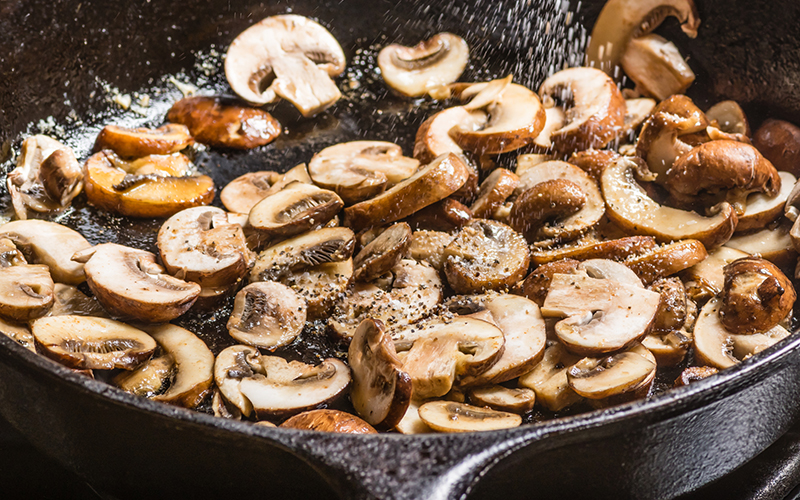
by guest blogger Toni Becker, member of the Rodale’s editorial team, adapted from a Rodale’s Organic Life article by Jean Nick, senior information analyst at Rodale, Inc.
You’ve heard about it, perhaps thought about trying it, but for some reason, you still haven’t done it. It’s time to do yourself (and your family) one fantastic favor and start cooking with cast iron. Here’s what you need to know to get started:
1. Why is cast iron so special?
Cast iron has a high volumetric heat capacity, meaning when it gets hot, it stays hot, for consistent cooking. Plus, it throws off a lot of heat energy, so it’s not just heating the surface, but everything in contact with the pan. Meat comes out perfectly seared and juicy—and vegetables, crisp and delicious. Also, it’s healthy for you and your family—unlike those modern nonstick surfaces that may not be the safest, or the most durable. These pans become naturally nonstick over time and will last a lifetime.
Bonus: Cooking in cast iron can also increase your food’s iron content.
2. What can you cook?
These pans are truly versatile. With the exception of a few foods you want to avoid (like delicate fish and omelets, which can affect the pan’s seasoning) you can cook almost anything. In fact, while most people think of just searing meat, there are a lot of other foods that taste better when cooked in a cast-iron pan, including pizza and lasagna. The more you use your pan, the more seasoned it becomes, so keep on cooking!
3. How do I get started?
While you will need to prep your pan for seasoning and then season it, it’s not difficult to do. In fact, Lodge skillets come preseasoned with a soy-based vegetable oil, letting you skip this initial step. If yours doesn’t, you’ll want to begin with a thorough scrub and then dry the pan in the oven. Next you’ll apply the fat or oil (like grass-fed lard, olive oil, or duck fat), and bake at 300-350 degrees for several hours. Read about the full preseasoning and seasoning process to make your skillet last forever. You want to make sure you get it right the first time!
4. Is caring for cast iron difficult?
As with any cookware, cast iron does have its own set of care instructions, but they’re not hard to follow. The more you use it, the darker and shinier your pan will get. A stainless steel spatula with a straight edge and curved corners will help polish the pan’s inside surface, making it even smoother and more nonstick. Don’t wait too long after cooking to clean your pan, especially when cooking acidic foods. In fact, it’s a good idea to avoid using your pan for acidic foods altogether until the pan is well seasoned.
You should never soak your pan or put it in the dishwasher, yet cleanup will be super easy because of how nonstick seasoned cast-iron pans become. For messier dishes, grab a natural-fiber or nylon brush and some hot water (maybe some kosher salt for stuck-on bits), and watch the video on supereasy cast-iron cleaning hacks.
When you’re done cleaning it, apply a coat of oil and rest your pan in an uncovered dry spot, such as an unheated oven or a hook on the wall.
5. What kind of cast-iron pan should I get?
It’s important to invest in a good pan which will last a lifetime. Lodge is America’s oldest family-owned cookware foundry and makes virtually indestructible pans that can last for generations. The 9-inch cast-iron skillet is a classic pan, and can be used on a number of cooking surfaces, from grills to campfires. There’s also the 6.5-inch personal skillet for smaller dishes, and the 10.75-inch cast-iron grill pan is perfect for grilling meats.
Happy healthy cooking!
 Toni Becker is a part-time content creator at Rodale’s. She is also the personal chef, event planner, chauffeur, and best of all playmate to her young daughter. Her family of three lives in the woods where she finds time to write, cook anything she can from scratch, garden, and build her case of why she needs goats.
Toni Becker is a part-time content creator at Rodale’s. She is also the personal chef, event planner, chauffeur, and best of all playmate to her young daughter. Her family of three lives in the woods where she finds time to write, cook anything she can from scratch, garden, and build her case of why she needs goats.
Adapted from the Rodale’s Organic Life article, “Make Your Favorite Skillet Last Forever.”




No comments yet.